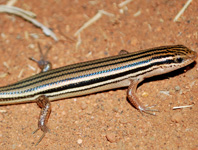Abstract
Siphonophores are poorly studied despite their abundance and ecological importance in marine ecosystems. The genus Lensia Totton, 1932 contains the highest number of species within Siphonophora, but systematic studies of these organisms are scarce in the literature. This study presents a phylogenetic analysis for fifteen species of Lensia based on morphological data. The material for this study was obtained during two oceanographic campaigns made along the southeastern Brazilian coast. A total of twenty two characters of the anterior nectophore morphology were scored. The shortest trees were searched using parsimony (under different weighting regimes). All analyses provided the same topology: (M. kochi (D. dispar + D. bojani) (L. leloupi (L. havock (L. conoidea (L. subtilis; L. meteori; L. hardy; L. fowleri; (L. subtiloides (L. hotspur; L. cossack; L. campanella)); (L. multicristata (L. hunter (L. lelouveteau + L. grimaldii))). The monophyly of the genus Lensia is supported by the hydroecium measuring up to 1/4 the height of the nectosac.
References
Alvariño, A. & Wojtan, J.M. (1984) Three new species of Lensia, and description of the eudoxia stages of Lensia reticulata and Lensia lelouveteau (Calycophorae: Siphonophorae). Proceedings of the Biological Society of Washington, 97 (1), 49–59.
Dunn, C.W. & Wagner, P.G. (2006) The evolution of colony-level development in the Siphonophora (Cnidaria: Hydrozoa). Development Genes and Evolution, 216, 743–754.
http://dx.doi.org/10.1007/s00427-006-0101-8Dunn, C.W., Pugh, P.R. & Haddock, S.H.D. (2005) Molecular phylogenetics of the Siphonophora (Cnidaria), with implications for the evolution of functional specialization. Systematic Biology, 54, 916–935.
http://dx.doi.org/10.1080/10635150500354837Goloboff, P.A. (1993) Estimating character weights during tree search. Cladistics, 9, 83–91.
http://dx.doi.org/10.1111/j.1096-0031.1993.tb00209.xGoloboff, P.A., Farris, J.S. & Nixon, K.C. (2003) TNT: Tree analysis using new technology. Distributed by the authors. Available from: www.zmuc.dk/public/phylogeny (accessed 14 June 2016)
Grossmann, M.M., Collins, A.G. & Lindsay, D.J. (2014) Description of the eudoxid stages of Lensia havock and Lensia leloupi (Cnidaria: Siphonophora: Calycophorae), with a review of all known Lensia eudoxid bracts. Systematics and Biodiversity, 12 (2), 163–180.
http://dx.doi.org/10.1080/14772000.2014.902867Kirkpatrick, P.A. & Pugh, P.R. (1984) Siphonophores and Velellids. Synopses of the British Fauna New Series, 29, 1–154.
Mackie, G.O. (1964) Analysis of locomotion in a siphonophore colony. Proceedings of the Royal Society B: Biological Sciences, 159, 366–391.
http://dx.doi.org/10.1098/rspb.1964.0008Mapstone, G.M. (2014) Global diversity and review of the Siphonophorae. PLOS One, 9 (2), 1–37.
http://dx.doi.org/10.1371/journal.pone.0087737Nixon, K.C. & Carpenter, J.M. (1993) On outgroups. Cladistics, 9, 413–426.
http://dx.doi.org/10.1111/j.1096-0031.1993.tb00234.xPagès, F. & Gili, J.M. (1992) Siphonophores (Cnidaria, Hydrozoa) of the Benguela Current (southeastern Atlantic). Scientia Marina, 56, 65–112.
Pugh, P.R. (1999) Siphonophorae. In: Boltvoskoy, D. (Ed.), Zooplankton. Vol. 1. Backhuys Publishers, Leiden, pp. 467–513.
Totton, A.K. (1932) Siphonophora. Scientific Reports of the Great Barrier Reef Expedition, 4 (10), 317–374.
Totton, A.K. (1965) A Synopsis of the Siphonophora. Trustees of the British Museum (Natural History), London, 230 pp.

